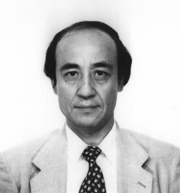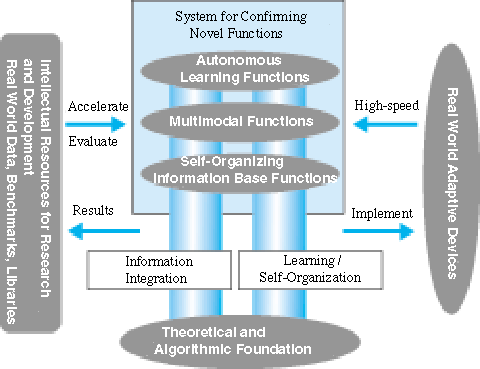
| Nobuyuki Otsu Director, Real World Intelligence Center (Director, Machine Understanding Division, Electrotechnical Laboratory) |

| Nobuyuki Otsu Director, Real World Intelligence Center (Director, Machine Understanding Division, Electrotechnical Laboratory) |
Computer information processing which has advanced through its modeling after the logical aspects of human intelligence is penetrating into various scenes in our every-day lives, and the information infrastructure represented by multimedia and the Internet has also been flourishing. Today's information technology is indeed quite powerful in terms of its fast information processing according to pre-defined procedures in a presupposed information world.
However, today's information technology still lacks the flexibility of the information processing which humans carry out daily, that is, today¹s information technology still lacks sufficient ability to comprehend and judge various kinds of information in the real world which includes uncertainty and ambiguity, or the ability to adapt its processing functions to certain situations, or the ability to acquire such functions through learning. As the information infrastructure advances, the processing ability to create, display, and transport various types of information in the real world including images and speech, as well as symbols has grown rapidly; but the ability to integrate, summarize, and understand such information lags behind. In addition, a more daily and natural form of interaction (interface) with computers expected beyond GUI is desirable, including the recognition of speech and gestures. In order to enable robots to go out of factories into the real world, autonomy supported by information integration and learning capability is required.
Thus, current information technologies are weak at intelligent information processing which can function with no problems, in a user-friendly manner, in the ever-changing real world environment, that is, ³Real World Intelligence,² and efforts towards achieving this capability are forming a common bottleneck in pioneering new potential and new applications.
The goal of the research and development on Real World Intelligence in the Project for Fundamental Information Technology of the Next Generation is to develop fundamental technologies for adding such ³Real World Intelligence², that is, the ability of information integration and learning-type information processing to conventional information technologies to broaden the potential and application domain of information processing. Information integration and learning/self-organization have been separately studied so far, but the ability to overcome the novelty and challenge in accomplishing real world intelligence lies in achieving these abilities in a consistent and integrated manner.
In addition, information integration and learning/self-organization should be dealt with by integrating them with recognition and reasoning functions. What is important for their integration as a theoretical framework is stochastic and statistical methods such as co-occurrence frequency and the correlation of various events, and the Bayesian network to deal with uncertain information in the real world. Using these information integration and learning/self-organization functions as a common backbone, a system to closely tie the research on a theoretical foundation and the research and development in line with actual applications is critical.
Hence, real world intelligence applications are divided into information summarization, dialogue, and action; and the research and development of each will be carried out according to specific prototype systems, and then essential problems in real world intelligence will be solved and verified of their functions. Also of importance, is the development of new adaptive devices such as evolving hardware to support, accelerate, and evaluate these R&D activities from both hardware and software perspectives; and the establishment of intellectual resources such as various real-world databases and libraries for common techniques, which both lead to the Research and Development System as shown in the figure.
The Electrotechnical Laboratory abolished the conventional research laboratory system in April this year, and shifted to a more mission-oriented laboratory system. With this, super-laboratory, the "Real World Intelligence Center" has been established, which consists of eight laboratories related to this project, and a new system especially for guiding the research and development of the Real World Intelligence Field. We have decided to create a new wave for the research and technology of real world intelligence with an international perspective on working groups of each research area and cooperative committees beyond the areas under the collaboration of industrial, governmental, and academic sectors.
